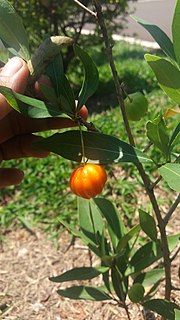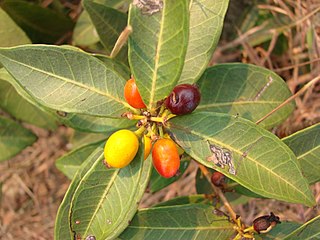
Myrtaceae or the myrtle family is a family of dicotyledonous plants placed within the order Myrtales. Myrtle, pohutukawa, bay rum tree, clove, guava, acca (feijoa), allspice, and eucalyptus are some notable members of this group. All species are woody, contain essential oils, and have flower parts in multiples of four or five. The leaves are evergreen, alternate to mostly opposite, simple, and usually entire. The flowers have a base number of five petals, though in several genera the petals are minute or absent. The stamens are usually very conspicuous, brightly coloured and numerous.

Eugenia is a genus of flowering plants in the myrtle family Myrtaceae. It has a worldwide, although highly uneven, distribution in tropical and subtropical regions. The bulk of the approximately 1,100 species occur in the New World tropics, especially in the northern Andes, the Caribbean, and the Atlantic Forest of eastern Brazil. Other centers of diversity include New Caledonia and Madagascar. Many of the species that occur in the Old World have received a new classification into the genus Syzygium.

Eugenia is a metro station along Line 3 of the Mexico City Metro. It is located in the Colonia Vertiz Narvarte and Colonia del Valle neighbourhoods of the Benito Juárez borough of Mexico City.

Syzygium is a genus of flowering plants that belongs to the myrtle family, Myrtaceae. The genus comprises about 1200 species, and has a native range that extends from Africa and Madagascar through southern Asia east through the Pacific. Its highest levels of diversity occur from Malaysia to northeastern Australia, where many species are very poorly known and many more have not been described taxonomically.

A true toad is any member of the family Bufonidae, in the order Anura. This is the only family of anurans in which all members are known as toads, although some may be called frogs. The bufonids now comprise more than 35 genera, Bufo being the best known.

Eugenia brasiliensis, with common names Brazil cherry and grumichama, or the Brazilian cherry is medium-sized tree endemic (native) to southern Brazil which bears small fruits that are purple to black in color, and have a sweet cherry to plum-like flavor.
Eugenia Cauduro is a Mexican actress and model.

Cerro Macá is a stratovolcano located to the north of the Aisén Fjord and to the east of the Moraleda Channel, in the Aysén del General Carlos Ibáñez del Campo Region of Chile. This glacier-covered volcano lies along the regional Liquiñe-Ofqui Fault Zone.
Sarcohyla chryses, also known as the golden treefrog, is a species of frog in the family Hylidae. It is endemic to the Sierra Madre del Sur in Guerrero, Mexico. Its sister species is Sarcohyla mykter.
Eugenia gatopensis is a species of plant in the family Myrtaceae. It is endemic to New Caledonia.

Eugenia reinwardtiana is a shrub to small tree in the family Myrtaceae,. Also known as the Cedar Bay cherry. Other common names includes; Beach Cherry, Australian Beach, Mountain Stopper, and Nioi (Hawaii). They are typically 2 to 6 m in height.
Curitiba is a monotypic genus of plant in family Myrtaceae, endemic to Brazil. The only species in the genus, Curitiba prismatica, was originally described as Eugenia prismatica by D.Legrand in 1969 and moved to its own genus by Andrew M. Salywon and Leslie Roger Landrum in 2007.

Eurema daira, the fairy yellow, barred yellow or barred sulphur, is a butterfly of the family Pieridae. The species was first described by Jean-Baptiste Godart in 1819. It is found from Argentina north to the southern United States. Strays can be found up to southern Arizona, South Dakota, southern Texas and even Washington, D.C.
The Miaolingian is the third Series of the Cambrian period, and was formally named in 2018. It lasted from about 509 to 497 million years ago and is divided in ascending order into 3 stages: the Wuliuan, Drumian, and Guzhangian. The Miaolingian is preceded by the unnamed Cambrian Series 2 and succeeded by the Furongian series.

Mary Eugenia Wharton was an American botanist, author, and environmental activist.

Myrteae is the largest tribe in the plant family Myrtaceae. It includes most of the species of the family that have fleshy fruits.

Eugenia pitanga, commonly known as pitanga do cerrado or savanna pitanga, is a species of plant in the family Myrtaceae. It is found in the savannahs and grasslands of Argentina, Paraguay, and Brazil. It is a deciduous shrub that grows up to 2 metres tall, has rhizomatous rootstock allowing it to form dense thickets, and produces red, edible fruit, 15-25mm in diameter.

Eugenia calycina, also known as savannah cherry, field cherry, Jabuti cherry, Grao de galo, cerejinha, cereja de cerrado, pitanga-vermelha, red pitanga, pitanga cherry of cerrado, and ca-ajaboti, is a flowering shrub in the family Myrtaceae.












